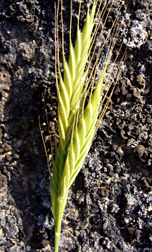This page has been archived and is being provided for reference purposes only. The page is no longer being updated, and therefore, links on the page may be invalid.
|
|
New Genetic Resources for Cereal Crops
By Don ComisNovember 13, 2008
An Agricultural Research Service (ARS) scientist has developed a special population of plants of the wild grass Brachypodium distachyon (Brachypodium) that will help speed up scientists' search for genes that could help wheat and other major crops resist diseases such as Ug99, a form of stem rust that threatens 80 percent of the world's wheat.
The plants developed by ARS plant geneticist David Garvin are the first recombinant inbred line (RILs) population of Brachypodium. This means offspring of each line in the population will retain the same genetic identity in perpetuity, according to Garvin, who works at the ARS Plant Science Research Unit in St. Paul, Minn. This allows scientists to more efficiently explore the genetic and molecular basis of a range of traits.
Previously, Garvin had developed earlier versions of populations segregating for genes and traits, but those populations permitted only one look at the genetics of a given trait. With the new RILs, all the offspring of each line will always have the same genes, so scientists around the world can repeat experiments as often as they desire.
The ability to work with large numbers of plants with the same genetic makeup gives scientists the opportunity to obtain highly accurate information on the number of genes that control a trait. This provides a strong start toward identifying the location of these genes on Brachypodium chromosomes.
It took Garvin more than three years to create the RILs. The research involved crosses and growing the entire population to maturity repeatedly to fix the genetic make-up of each plant. He has many additional RIL populations nearing completion.
ARS is a scientific research agency within the U.S. Department of Agriculture.

